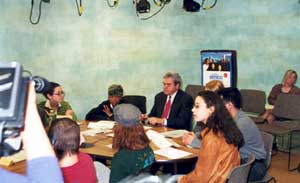
Students from Northern Ireland and New York Discuss Impact of Terrorism and
Hopes for the Future in a Videoconference
Students from New York and Northern Ireland shared stories about their experiences with terrorism in a videoconference hosted by BMCC on April 26, 2002, as a part of Global Youth Services Day. The students discussed the September 11 attacks in New York and the 1998 bomb in Omagh, Northern Ireland, with special emphasis on coping and moving on in the aftermath of the attacks.
In mid-August 1998 in Omagh, Northern Ireland, the blast came on the final day of the town’s weeklong annual carnival. The attack killed 29 people, nine of them children, one of them a pregnant woman; and injured 370. The IRA’s radical wing claimed responsibility for the car bomb attack that many proclaim as the worst since violence began in Northern Ireland over 30 years ago. Six students from Omagh and towns around it who were high school students at the time of the attacks participated in the videoconference.
The destruction and chaos of September 11 affected thousands of people, not only in New York City and Washington DC. However, BMCC’s location within walking distance of the World Trade Center made BMCC students especially vulnerable, during the attacks and in the seven months after them. Anil Khanchandani, Fatima Boone, and Lidija Markes took part in the videoconference representing the college and were joined by students from the neighboring Stuyvesant High School.
Students from both sides of the Atlantic, with the moderator Peter Mancuso, talked about their experiences of the attacks, what they were doing and how they were feeling when the attacks happened. “All of a sudden there was a loud noise and lots of smoke and fire, and I fell to the ground,” said Leanne Drum who was wounded in the Omagh bombing. Some students found themselves closer to the destruction; others viewed the events from more of a distance troubled by feelings of guilt for not being closer in order to help. “I turned on the TV and I couldn’t believe what I was seeing. Then I started thinking about all of my friends who were there, and I felt terrible for being safe at home. I wanted to be there to help,” said Fatima Boone from BMCC. Feelings of confusion and chaos permeated the first-hand accounts of both attacks.
New Yorkers can learn about the healing process from their Northern Irish counterparts. “The key is to move on,” emphasized Kelly Fox from Northern Ireland. “We are all in college and working on projects that will help our community heal,” she said. Styvesant High School senior, Zack Bernstein, corroborated her advice, “Focusing on preparing and applying to college somehow helped keep my mind off of it.”
Events like this videoconference may help both sides by enabling them to talk about their experiences and offer support. Richard Eastman from Virtual Presence International coordinated the videoconference and expressed hope that it marks the beginning of further exchanges on terrorism and its impact, especially on young people.
A webcast of the videoconference may be viewed until May 26 at this url: http://boss.streamos.com/real/federal/vpi/80_vpi042602.smi
RELATED ARTICLES: BOROUGH OF MANHATTAN COMMUNITY COLLEGE HOSTS INTERNATIONAL VIDEOCONFERENCE ON TERRORISM APRIL 26 AS PART OF GLOBAL YOUTH SERVICES DAY

